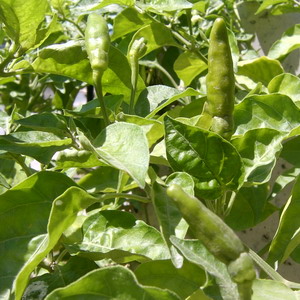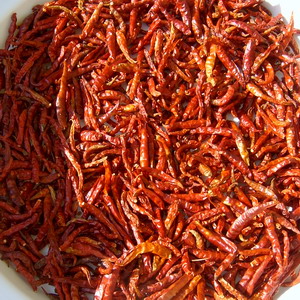Thai Chili Plant

Thai Chili Cut Open

Sun Dried Chili Seeds

Sun Dried Chili

The Hottest Chilli Pepper Seeds in the World
By: Ryan Frank
Chilli pepper seeds are an integral part of many culturesí cuisine. There are literally thousands of different hot pepper seeds from almost every single country in the world, ranging in flavor, appearance and hotness. The following is a list of some of the worldís hottest chilli seeds. Take a look and see if you have what it takes to try a few of them.
Bhut Jolokia
The Bhut Jolokia chilli pepper is the current Guinness World Book Record Holder for having the hottest chilli pepper seeds in the world. Bhut Jolokia peppers come from Assam, a region in North East India and they have an SHU rating of 1,001,304 SHU. The previous record holder, the Red Savina, had only half of that. SHU stands for Scoville Heat Unit, and it measures the amount of water thatís required before the chilliís hotness is undetectable. For those of you who can not pronouce, bhut jolokia, another common name is the Ghost Pepper.
Naga Morich
One of the most respected chiles in the world, the Naga Morich has on average a heat of around 800,000 to 900,000 SHU. The Naga Morich comes from Bangladesh and it is the closest relative to the Dorset Naga.
Super Chili
This is a very popular variety of chilli because it germinates quickly and yields a lot of peppers. You can grow it easily in most climates and it is extremely hot when ripe. When it matures, itís color changes from green to red.
The Habanero
Continued Here
|
|
Thai Chili
Looking at wiki we get these variations on how to spell the word Chili, chilli pepper, chilli, chillie, chili, and chile, so take your pick and stick with it.
Thai Chilli or mouse shit peppers (Phrik Kee Noo) as they are known in Thailand are a major ingredient of most Thai Recipes, Thai Food would not be Thai Food in the most part if it wasn't for Thai Chillies, luckily Chili plants are extremely easy to grow either from seeds or even from cuttings, although it is extremely rare for people to grow chilli from cuttings due to the numerous amount of seeds one gets out of each pepper.
For some reason Thai chilli has been renamed to birdseye chilli for the rest of the world, maybe asking if you want more mouse shit peppers with your dish isn't so appealing to the western appetite.
First you need some chili seeds, these are available at most Thai nurseries and orchid centers for around 20baht a packet, if you are using seeds from a plant you need to dry them, a day in the sun will do that here in Thailand.
Capsicum Peppers Origin
Capsicum Peppers Origin
Author: Eric Castro
Capsicum is a genus of plants from the Solanaceae family, cultivated for thousands of years by the people of the tropical Americas. The term chilli or chile is widely used and it refers exclusively to the smaller, hot types of capsicum fruits. Its orthography is common in Spanish although the name varies depending on the location. For example, in South America it is better known as ajŪ, locoto or rocoto, meanwhile in USA it is called bell pepper and in Canada and the United Kingdon only like pepper.
Continued Here
|
Pinching off Chilis
The best way to preserve a Chili
The best way to preserve a Chili
There are several ways of preserving chilies and my favorite has to be drying, but more of that later.
The simplest way to preserve a chili is to freeze it. One of the major problems with this is that the chili then loses its eating quality. If you eat a raw chili, and be very careful here about the strength of any chili you eat, there is a crispy crunchy texture to the chili. If you defrost a chili and try this then you will find that this crispness has gone and the texture is soggy. This may not be a problem depending on what you intend to use the chili for. If it is to cook with then there are no drawbacks to freezing and I often just cut the stalk off the chilies and put them through a food processor to make a firm paste which I then freeze in ice cube trays. Once these are frozen I can put them in a bag and take out as many as I need to cook with.
Continued Here
|
|
|






